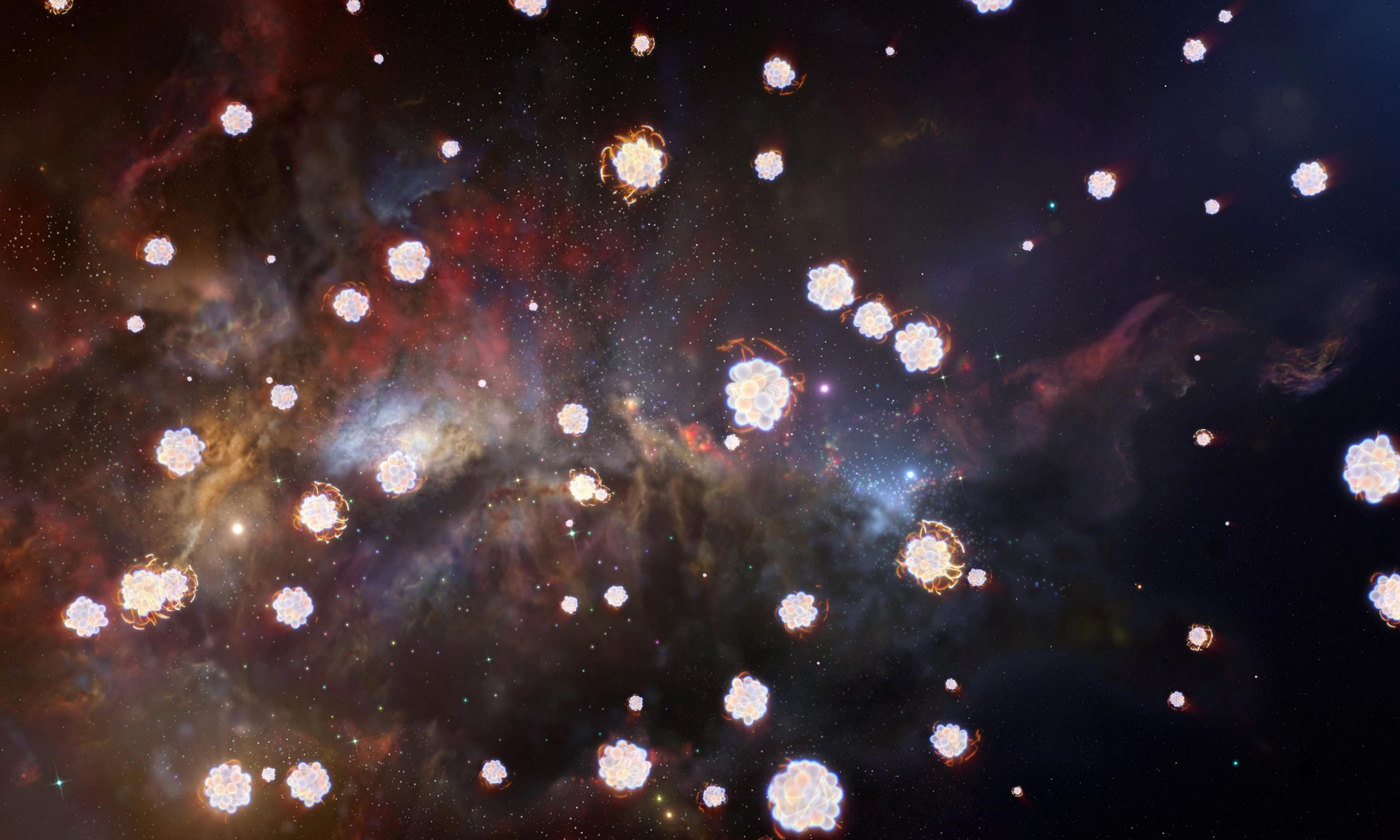
Posted on 05/03/2023 1:10:55 PM PDT by Red Badger

Chemical Elements in a Distant Gas Cloud
This artist’s impression shows a distant gas cloud that contains different chemical elements, illustrated here with schematic representations of various atoms. Using ESO’s Very Large Telescope, astronomers have detected three distant gas clouds whose chemical composition matches what we expect from the explosions of the first stars that appeared in the Universe. These early stars can be studied indirectly by analyzing the chemical elements they dispersed into the surrounding environment after they died in supernova explosions. The three distant gas clouds detected in this study are rich in carbon, oxygen, and magnesium, but poor in iron. This is exactly the signature expected from the explosions of the first stars. Credit: ESO/L. Calçada, M. Kornmesser
Using ESO’s Very Large Telescope (VLT), researchers have found for the first time the fingerprints left by the explosion of the first stars in the Universe. They detected three distant gas clouds whose chemical composition matches what we expect from the first stellar explosions. These findings bring us one step closer to understanding the nature of the first stars that formed after the Big Bang.
“For the first time ever, we were able to identify the chemical traces of the explosions of the first stars in very distant gas clouds,” says Andrea Saccardi, a PhD student at the Observatoire de Paris – PSL, who led this study during his master’s thesis at the University of Florence.
Researchers think that the first stars that formed in the Universe were very different from the ones we see today. When they appeared 13.5 billion years ago, they contained just hydrogen and helium, the simplest chemical elements in nature.[1] These stars, thought to be tens or hundreds of times more massive than our Sun, quickly died in powerful explosions known as supernovae, enriching the surrounding gas with heavier elements for the first time. Later generations of stars were born out of that enriched gas, and in turn, ejected heavier elements as they too died. But the very first stars are now long gone, so how can researchers learn more about them? “Primordial stars can be studied indirectly by detecting the chemical elements they dispersed in their environment after their death,” says Stefania Salvadori, Associate Professor at the University of Florence and co-author of the study published today in the Astrophysical Journal.
VIDEO AT LINK..........
Using ESO’s Very Large Telescope, astronomers have found the fingerprints left by the explosions of the first stars. Credit: ESO
Using data taken with ESO’s VLT in Chile, the team found three very distant gas clouds, seen when the Universe was just 10–15% of its current age, and with a chemical fingerprint matching what we expect from the explosions of the first stars. Depending on the mass of these early stars and the energy of their explosions, these first supernovae released different chemical elements such as carbon, oxygen and magnesium, which are present in the outer layers of stars. But some of these explosions were not energetic enough to expel heavier elements like iron, which is found only in the cores of stars. To search for the telltale sign of these very first stars that exploded as low energy supernovae, the team therefore looked for distant gas clouds poor in iron but rich in the other elements. And they found just that: three faraway clouds in the early Universe with very little iron but plenty of carbon and other elements — the fingerprint of the explosions of the very first stars.

Measuring the Chemical Composition of a Gas Cloud
This diagram illustrates how astronomers can analyze the chemical composition of distant clouds of gas using the light of a background object like a quasar as a beacon. When the light of the quasar passes through the gas cloud, the chemical elements in it absorb different colors or wavelengths, leaving dark lines in the spectrum of the quasar. Each element leaves a different set of lines, so by studying the spectrum astronomers can work out the chemical composition of the intervening gas cloud. Credit: ESO/L. Calçada
This peculiar chemical composition has also been observed in many old stars in our own galaxy, which researchers consider to be second-generation stars that formed directly from the ‘ashes’ of the first ones. This new study has found such ashes in the early Universe, thus adding a missing piece to this puzzle. “Our discovery opens new avenues to indirectly study the nature of the first stars, fully complementing studies of stars in our galaxy,” explains Salvadori.
To detect and study these distant gas clouds, the team used light beacons known as quasars — very bright sources powered by supermassive black holes at the centers of faraway galaxies. As the light from a quasar travels through the Universe, it passes through gas clouds where different chemical elements leave an imprint on the light.
To find these chemical imprints, the team analyzed data on several quasars observed with the X-shooter instrument on ESO’s VLT. X-shooter splits light into an extremely wide range of wavelengths, or colors, which makes it a unique instrument with which to identify many different chemical elements in these distant clouds.
This study opens new windows for next-generation telescopes and instruments, like ESO’s upcoming Extremely Large Telescope (ELT) and its high-resolution ArmazoNes high Dispersion Echelle Spectrograph (ANDES). “With ANDES at the ELT we will be able to study many of these rare gas clouds in greater detail, and we will be able to finally uncover the mysterious nature of the first stars,” concludes Valentina D’Odorico, a researcher at the National Institute of Astrophysics in Italy and co-author of the study.
Notes
Minutes after the Big Bang the only elements present in the Universe were the three lightest ones: hydrogen, helium and very small traces of lithium. Heavier elements were formed much later on in stars. This research was presented in a paper to appear in the Astrophysical Journal.
Reference: “Evidence of first stars-enriched gas in high-redshift absorbers” 3 May 2023, Astrophysical Journal.
DOI: 10.3847/1538-4357/acc39f
The team is composed of Andrea Saccardi (GEPI, Observatoire de Paris, Université PSL, CNRS, France; Dipartimento di Fisica e Astronomia, University of Florence, Italy [UFlorence]), Stefania Salvadori (UFlorence; INAF – Osservatorio Astrofisico di Arcetri, Italy), Valentina D’Odorico (Scuola Normale Superiore, Italy; INAF – Osservatorio Astrofisico di Trieste, Italy [INAF Trieste]; IFPU – Institute for Fundamental Physics of the Universe, Italy [IFPU]), Guido Cupani (INAF Trieste; IFPU), Michele Fumagalli (Dipartimento di Fisica G. Occhialini, University of Milano Bicocca, Italy; INAF Trieste), Trystyn A. M. Berg (Dipartimento di Fisica G. Occhialini, University of Milano Bicocca, Italy), George D. Becker (Department of Physics & Astronomy, University of California, USA), Sara Ellison (Department of Physics & Astronomy, University of Victoria, Canada), Sebastian Lopez (Departamento de Astronomía, Universidad de Chile, Chile).
Ashes to ashes, dust to dust..................
Tell us all about it. As if it’s not merely a theory.
Tell us all about it. As if it’s not mere a theory.
We know Major Tom’s a junkie.
These science guys do amazing things. I count myself lucky to be alive during a time I get to find out this stuff.
Other first stars:
https://www.youtube.com/watch?v=aHKY3t2nZYw
Cool stuff!
Lots going on in BIG telescope construction!
A local company, Ingersoll Machine Tool, is building the support structure for the Great Magellan Telescope, which is going to be much larger than this one.
Can’t wait to see what the GMT is going to show us!
Well, that explains my sneezing issues when the sun goes down...
Danged dust!
They are going to fall off the edge any day now.




I miss The Far Side!
One “Far Side” moment I experienced many years ago was at a local shopping mall when we put on an Astronomy Day exhibit. Some of us had telescopes set up and shoppers would stop and ask us questions about them.
One lone individual asked me what I could see with my scope, and I explained that we could see galaxies, nebulae, planets, and craters on the Moon.
He then asked me, with a straight face, if I ever saw “ angel babies” on the Moon, and that he could see “naked angel babies” on the Moon. And he walked away with no expression on his face.
To this day I don’t know if he was putting me on or not.
Weird…
“Angel Babies” is a euphemism for a baby that has died....................
If you could’ve seen this guy, somehow, I’m not sure that that is what he meant. It freaked me out at the time.
 ........<-----THIS HIM?................
........<-----THIS HIM?................
LOL, no….
Disclaimer: Opinions posted on Free Republic are those of the individual posters and do not necessarily represent the opinion of Free Republic or its management. All materials posted herein are protected by copyright law and the exemption for fair use of copyrighted works.